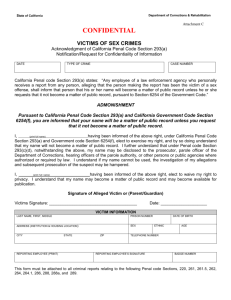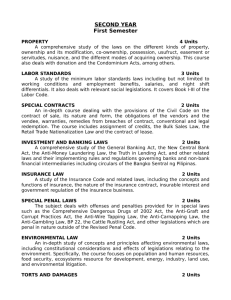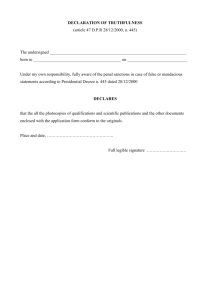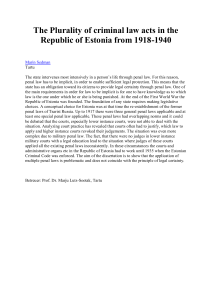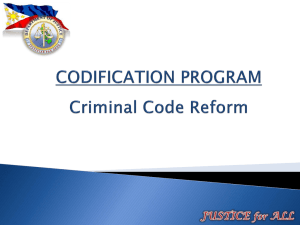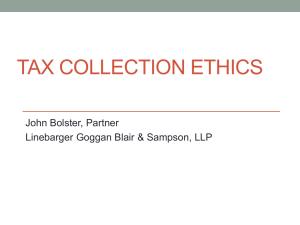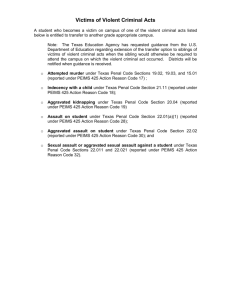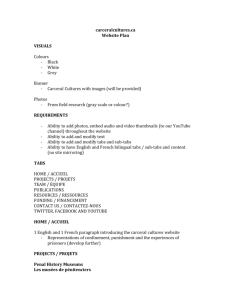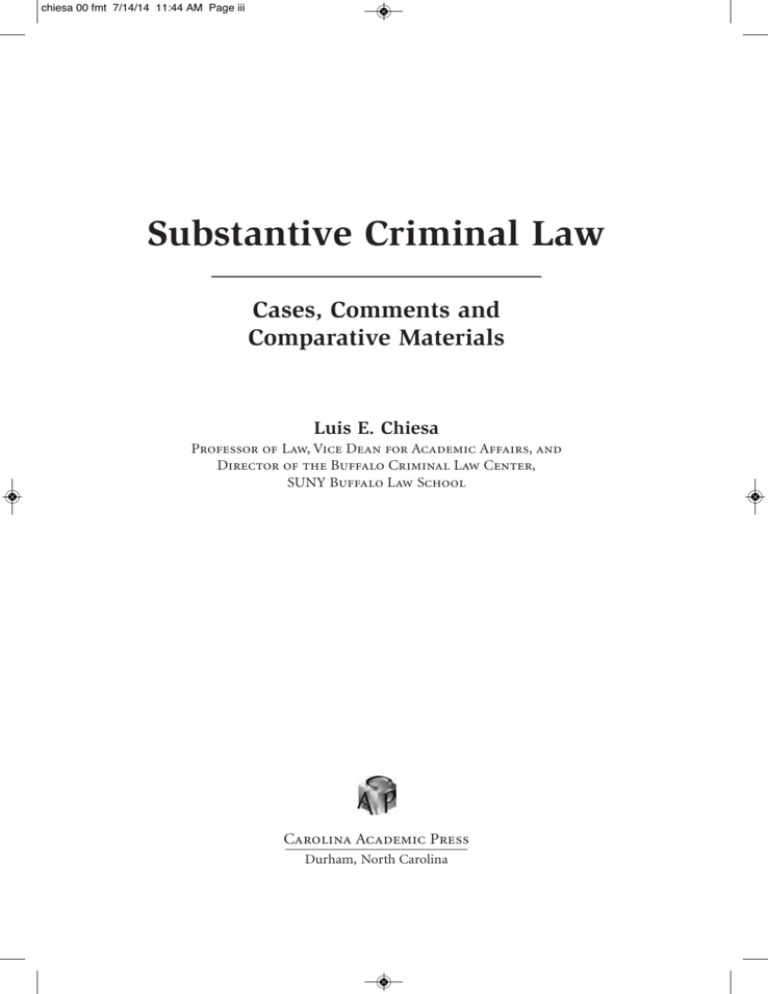
chiesa 00 fmt 7/14/14 11:44 AM Page iii
Substantive Criminal Law
Cases, Comments and
Comparative Materials
Luis E. Chiesa
Professor of Law, Vice Dean for Academic Affairs, and
Director of the Buffalo Criminal Law Center,
SUNY Buffalo Law School
Carolina Academic Press
Durham, North Carolina
chiesa 00 fmt 7/14/14 11:44 AM Page iv
Copyright © 2014
Luis E. Chiesa
All Rights Reserved
ISBN 978-1-61163-528-7
LCCN 2014937538
Carolina Academic Press
700 Kent Street
Durham, North Carolina 27701
Telephone (919) 489-7486
Fax (919) 493-5668
www.cap-press.com
Printed in the United States of America
chiesa 00 fmt 7/14/14 11:44 AM Page v
To Karla, for selflessly allowing me to follow my passion for criminal law from the warm
beaches of Puerto Rico to the cold and snowy shores of Lake Erie.
chiesa 00 fmt 7/14/14 11:44 AM Page vi
chiesa 00 fmt 7/14/14 11:44 AM Page vii
Contents
Table of Cases
Preface
Acknowledgments
xxi
xxvii
xxix
Part One · The Nature and Purposes of Criminal Law
Chapter 1 · The Nature of Punishment
§ 1.01 Distinguishing Punishment from Civil Sanctions: In General
Kennedy v. Mendoza Martínez
Notes and Questions
§ 1.02 Distinguishing Punishment from Civil Sanctions: Model Penal Code
Model Penal Code Section 1.04. Classes of Crime. Violations.
Notes and Questions
§ 1.03 Distinguishing Punishment from Civil Sanctions: Recent Developments
Smith v. Doe
Notes and Questions
§ 1.04. Distinguishing Punishment from Civil Sanctions: Comparative
Perspectives
Judgment of the Spanish Constitutional Court 32/1987
Notes and Questions
§ 1.05 Distinguishing Punishment from Civil Sanctions: Scholarly Debates
H.L.A. Hart, Punishment and Responsibility
Joel Feinberg, The Expressive Function of Punishment
Leo Zaibert, Punishment and Retribution
Notes and Questions
3
3
3
7
8
8
8
9
9
13
Chapter 2 · Purposes of Punishment
§ 2.01 Purposes of Punishment: In General
United States v. Irey
Notes and Questions
§ 2.02 Purposes of Punishment: Model Penal Code
Model Penal Code (First Draft) Section 1.02(2). Purposes.
Notes and Questions
§ 2.03 Purposes of Punishment: Comparative Perspectives
Günther Jakobs, Derecho Penal: Parte General
Notes and Questions
§ 2.04 Purposes of Punishment: Scholarly Debates
Dan Kahan, What Do Alternative Sanctions Mean?
21
21
21
27
29
29
29
30
30
31
32
32
vii
14
14
15
16
16
16
17
18
chiesa 00 fmt 7/14/14 11:44 AM Page viii
viii
CONTENTS
Michael Moore, Closet Retributivism
Victor Tadros, The Ends of Harm: The Moral Foundations of
Criminal Law
Paul H. Robinson, The Ongoing Revolution in Punishment Theory:
Doing Justice as Controlling Crime
Christopher Slobogin & Lauren Brinkley Rubinstein, Putting
Desert in Its Place
Notes and Questions
33
34
36
40
43
Part Two · Limits on the State’s Power to Punish
Chapter 3 · Principle of Legality
§ 3.01 Principle of Legality: In General
John Calvin Jeffries, Jr., Legality, Vagueness and the Construction of
Criminal Statutes
Notes and Questions
§ 3.02 Principle of Legality: Abolition of Common Law Crimes
State v. Soto
Notes and Questions
§ 3.03 Principle of Legality: Prohibition of Retroactive Punishment
Stogner v. California
Notes and Questions
§ 3.04 Principle of Legality: Prohibition of Vagueness
Rose v. Locke
Notes and Questions
§ 3.05 Principle of Legality: Prohibition of Retroactive Interpretation of
Statutes and the Rule of Lenity
McBoyle v. United States
Rogers v. Tennessee
People v. Cornett
Notes and Questions
§ 3.06 Principle of Legality: Model Penal Code
Model Penal Code Section 1.02. Purposes; Principles of Construction
State v. Lukas
Notes and Questions
§ 3.07 Principle of Legality: Comparative Perspectives
Judgment of the Spanish Constitutional Court 62/1982
Notes and Questions
§ 3.08 Principle of Legality: Scholarly Debates
Paul H. Robinson, Fair Notice and Fair Adjudication: Two Kinds of
Legality
John Calvin Jeffries, Jr., Legality, Vagueness and the Construction of
Criminal Statutes
Notes and Questions
47
47
Chapter 4 · Proportionality
§ 4.01 Proportionality: Non-Capital Cases Involving Adult Defendants
Harmelin v. Michigan
Notes and Questions
85
85
85
92
47
49
50
50
52
53
53
57
59
59
63
65
65
66
72
74
75
75
76
76
77
77
77
79
79
82
83
chiesa 00 fmt 7/14/14 11:44 AM Page ix
CONTENTS
§ 4.02 Proportionality: Death Penalty
Kennedy v. Louisiana
Notes and Questions
§ 4.03 Proportionality: Immature Defendants
Miller v. Alabama
Notes and Questions
§ 4.04 Proportionality: Alternative Approaches under State Constitutions
State v. Lewis
Bult v. Leaply
Notes and Questions
§ 4.05 Proportionality: Model Penal Code
Model Penal Code: Sentencing
Notes and Questions
§ 4.06 Proportionality: Comparative Perspectives
STS 68/1994
Notes and Questions
§ 4.07 Proportionality: Scholarly Debates
John Stinneford, Rethinking Proportionality under the Cruel and
Unusual Punishments Clause
William W. Berry III, Separating Retribution from Proportionality:
A Response to Stinneford
Notes and Questions
Chapter 5 · Constitutional Limits on Criminalization Decisions
§ 5.01 Criminalization Decisions: Liberty Interests Protected by Substantive
Due Process
Lawrence v. Texas
Notes and Questions
§ 5.02 Criminalization Decisions: Freedom of Speech
R.A.V. v. City of St. Paul
Notes and Questions
§ 5.03 Criminalization Decisions: Model Penal Code
Louis B. Schwartz, Morals Offenses and the Model Penal Code
Notes and Questions
§ 5.04 Criminalization Decisions: Comparative Perspectives
Argentine National Constitution, Article 19
Arriola Case
German Penal Code § 130 — Public Incitement
Notes and Questions
§ 5.05 Criminalization Decisions: Scholarly Debates
Bernard E. Harcourt, The Collapse of the Harm Principle
Eric Blumenson & Eva Nilsen, Liberty Lost: The Moral Case for
Marijuana Law Reform
Notes and Questions
ix
97
97
102
104
104
107
109
109
112
115
116
116
116
117
117
118
118
118
121
122
125
125
125
131
136
136
138
139
139
141
141
141
141
142
142
143
143
144
147
Part Three · The Elements of Punishable Crimes I — The Offense
Chapter 6 · Conduct: Action, Omission & Possession
§ 6.01 Conduct: The Voluntary Act Requirement
153
153
chiesa 00 fmt 7/14/14 11:44 AM Page x
x
CONTENTS
State v. Newman
Notes and Questions
§ 6.02 Conduct: Omissions
West v. Commonwealth
Notes and Questions
§ 6.03 Conduct: Possessions
Florida v. Adkins
Notes and Questions
§ 6.04 Conduct: Model Penal Code
§ 2.01. Requirement of Voluntary Act; Omission as Basis of
Liability; Possession as an Act.
Notes and Questions
§ 6.05 Conduct: Comparative Perspectives
Jesús María Silva Sánchez, Criminal Omissions: Some Relevant
Distinctions
Notes and Questions
§ 6.06 Conduct: Scholarly Debates
Joshua Dressler, Some Thoughts (Mostly Negative) about
Bad Samaritan Laws
David Hyman, Rescue Without Law: An Empirical Perspective on the
Duty to Rescue
Ken Levy, Killing, Letting Die, and the Case for (Mildly) Punishing
Bad Samaritanism
Notes and Questions
Chapter 7 · Causation
§ 7.01 Causation: Actual Causation
State v. Muro
Notes and Questions
§ 7.02 Causation: Legal (Proximate) Causation
People v. Acosta
Notes and Questions
§ 7.03 Causation: Third Party Conduct as an Intervening Cause
State v. García
Commonwealth v. Moyer
Notes and Questions
§ 7.04 Causation: Victim Conduct as an Intervening Cause
State v. Murray
Notes and Questions
§ 7.05 Causation: Model Penal Code
§ 2.03. Causal Relationship Between Conduct and Result; Divergence
Between Result Designed or Contemplated and Actual Result or
Between Probable and Actual Result.
Notes and Questions
§ 7.06 Causation: Comparative Perspectives
Claus Roxin, The Controversy over Cases in Which an Actor
Consents to Being Endangered by Someone Else’s Conduct
Notes and Questions
§ 7.07 Causation: Scholarly Debates
153
158
161
161
163
167
167
171
172
172
172
173
173
175
175
175
178
180
181
183
183
183
186
189
189
194
196
196
200
201
203
203
206
210
210
211
212
212
214
215
chiesa 00 fmt 7/14/14 11:44 AM Page xi
CONTENTS
Vera Bergelson, Victims and Perpetrators: An Argument for
Comparative Liability in the Criminal Law
Kenneth Simons, The Relevance of Victim Conduct in Tort and
Criminal Law
Notes and Questions
Chapter 8 · Subjective Offense Elements
§ 8.01 Subjective Offense Elements (Mens Rea): Common Law
Morissette v. United States
Notes and Questions
§ 8.02 Subjective Offense Elements (Mens Rea): Purpose and Knowledge
under the Model Penal Code
Model Penal Code § 2.02. General Requirements of Culpability.
Vermont v. Jackowski
Notes and Questions
§ 8.03 Subjective Offense Elements (Mens Rea): Recklessness under the
Model Penal Code
Model Penal Code § 2.02. General Requirements of Culpability.
In re D.G., Juvenile
State v. Loeffel
People v. Hall
Notes and Questions
§ 8.04 Subjective Offense Elements (Mens Rea): Negligence under the
Model Penal Code
Model Penal Code § 2.02. General Requirements of Culpability.
State v. Strescino
Notes and Questions
§ 8.05 Subjective Offense Elements (Mens Rea): Comparative Perspectives
Eugenio Raúl Zaffaroni, Alejandro Alagia & Alejandro Slokar,
Derecho Penal: Parte General
Notes and Questions
§ 8.06 Subjective Offense Elements (Mens Rea): Scholarly Debates
Larry Alexander, Insufficient Concern: A Unified Conception of
Criminal Liability
George Fletcher, The Fault of Not Knowing
Notes and Questions
Chapter 9 · Negating Subjective Offense Elements
§ 9.01 Negating Subjective Offense Elements (Mens Rea): Common Law
Approach to Mistake of Fact
Louisiana Revised Statutes 14–16
Busby v. State
Granger v. State
People v. Russell
Notes and Questions
§ 9.02 Negating Subjective Offense Elements (Mens Rea): Model Penal
Code Approach to Mistake of Fact
Model Penal Code § 2.04. Ignorance or Mistake.
State v. Sexton
xi
215
219
221
223
223
223
227
231
231
231
233
239
239
239
240
241
247
248
248
248
249
249
249
250
251
251
254
255
257
257
257
257
258
261
264
267
267
267
chiesa 00 fmt 7/14/14 11:44 AM Page xii
xii
CONTENTS
Notes and Questions
§ 9.03 Negating Subjective Offense Elements (Mens Rea): Common Law
Approach to Voluntary Intoxication
People v. Hood
Notes and Questions
§ 9.04 Negating Subjective Offense Elements (Mens Rea): Model Penal
Code Approach to Voluntary Intoxication
State v. Cameron
Notes and Questions
§ 9.05 Negating Subjective Offense Elements (Mens Rea): Comparative
Perspectives
Judgment of the Sixth Criminal Tribunal of Santiago, Chile (2007)
Notes and Questions
§ 9.06 Negating Subjective Offense Elements (Mens Rea): Scholarly Debates
Kyron Huigens, Fletcher’s Rethinking: A Memoir
Susan Estrich, Rape
Notes and Questions
273
Chapter 10 · Complicity
§ 10.01 Complicity: Common Law Distinction between Principals and
Accessories and Its Abrogation
Potts v. Florida
Notes and Questions
§ 10.02 Complicity: Objective Elements (Actus Reus)
State v. Vaillancourt
Porter v. State
Notes and Questions
§ 10.03 Complicity: Subjective Elements (Mens Rea) with Regard to the
Conduct Element of the Offense
People v. Beeman
Backun v. United States
United States v. Peoni
Notes and Questions
§ 10.04 Complicity: Subjective Elements (Mens Rea) with Regard to the
Result and Circumstance Elements of the Offense
Méndez v. State
Notes and Questions
§ 10.05 Complicity: Model Penal Code
Model Penal Code § 2.06. Liability for Conduct of Another;
Complicity
Commonwealth v. Roebuck
Notes and Questions
§ 10.06 Complicity: Comparative Perspectives
Spanish Penal Code: On persons criminally responsible for felonies
and misdemeanors
Notes and Questions
§ 10.07 Complicity: Scholarly Debates
Joshua Dressler, Rethinking Complicity Law: Trivial Complicity as a
Lesser Offense?
291
274
274
277
279
279
283
283
283
284
285
285
287
288
291
291
293
295
295
296
299
302
302
307
309
309
313
313
314
316
316
317
320
322
322
322
325
325
chiesa 00 fmt 7/14/14 11:44 AM Page xiii
CONTENTS
R.A. Duff, Is Accomplice Liability Superfluous?
Notes and Questions
xiii
327
329
Chapter 11 · Attempts
§ 11.01 Attempts: Conduct Element — Common Law Approaches
State v. Duke
People v. Rizzo
Notes and Questions
§ 11.02 Attempts: Conduct Element — Model Penal Code Approach
People v. Scott
United States v. Jackson
Notes and Questions
§ 11.03 Attempts: Subjective Offense Element (Mens Rea) — Common Law
Stennet v. State
People v. Thomas
Notes and Questions
§ 11.04 Attempts: Subjective Offense Element (Mens Rea) — Model
Penal Code
Model Penal Code § 5.01. Criminal Attempt.
State v. Nuñez
Notes and Questions
§ 11.05 Attempts: Impossible Attempts — Common Law
People v. Thousand
Notes and Questions
§ 11.06 Attempts: Impossible Attempts — Model Penal Code
People v. Thousand
Notes and Questions
§ 11.06 Attempts: Comparative Perspectives
Günther Jakobs, Derecho Penal Parte General
Hans Heinrich Jescheck & Thomas Weigend, Tratado de Derecho
Penal Parte General
Francisco Muñoz Conde & Mercedes García Arán, Derecho Penal
Parte General
Notes and Questions
§ 11.06 Attempts: Scholarly Debates
Sanford Kadish, Foreword: Criminal Law and the Luck of the Draw
Guyora Binder, Victims and the Significance of Causing Harm
Notes and Questions
331
331
331
333
334
339
339
342
348
351
351
352
355
370
371
371
371
375
379
Chapter 12 · Conspiracy
§ 12.01 Conspiracy: In General
Krulewitch v. United States
Notes and Questions
§ 12.02 Conspiracy: Conduct Elements
United States v. Shabani
People v. Persinger
People v. Foster
Notes and Questions
§ 12.03 Conspiracy: Subjective Elements
381
381
381
386
387
387
388
390
392
395
356
356
356
358
359
359
364
365
365
368
370
370
370
chiesa 00 fmt 7/14/14 11:44 AM Page xiv
xiv
CONTENTS
People v. Lauria
State v. Gunnison
Notes and Questions
§ 12.04 Conspiracy: Accessorial Liability
Pinkerton v. United States
People v. McGee
Notes and Questions
§ 12.05 Conspiracy: Model Penal Code
Minnesota v. St. Christopher
Notes and Questions
§ 12.06 Conspiracy: Comparative Perspectives
Sergio Politoff, La Conspiración Para Cometer Delitos Previstos
en la Ley Sobre Tráfico de Estupefacientes
Spanish Penal Code — Article 17
Notes and Questions
§ 12.07 Conspiracy: Scholarly Debates
Phillip E. Johnson, The Unnecessary Crime of Conspiracy
Neal Kumar Katyal, Conspiracy Theory
Notes and Questions
Chapter 13 · Corporate Criminal Liability
§ 13.01 Corporate Criminal Liability: Common Law
United States v. Basic Construction Co.
Vaughan and Sons, Inc. v. State
Notes and Questions
§ 13.02 Corporate Criminal Liability: Model Penal Code
Model Penal Code § 2.07. Liability of Corporations, Unincorporated
Associations and Persons Acting, or Under a Duty to Act, in
Their Behalf.
State v. Community Alternatives Missouri, Inc.
Notes and Questions
§ 13.03 Corporate Criminal Liability: Comparative Perspectives
Thomas Weigend, Societas Delinquere Non Potest
Notes and Questions
§ 13.04 Corporate Criminal Liability: Scholarly Debates
Albert Alschuler, Two Ways to Think about the Punishment of
Corporations
Sara Sun Beale, A Response to the Critics of Corporate Criminal
Liability
Notes and Questions
395
400
401
402
402
404
405
406
406
409
410
410
410
410
411
411
413
416
419
419
419
420
425
426
426
427
431
432
432
436
437
437
441
444
Part Four · The Elements of Punishable Crimes II — Absence of Justification
Chapter 14 · Lesser Evils
§ 14.01 Necessity: Distinguishing Necessity from Duress
Hunt v. Florida
Notes and Questions
§ 14.02 Necessity: Triggering Conditions — The Imminence of the Threat
Commonwealth v. Leno
449
449
449
451
452
452
chiesa 00 fmt 7/14/14 11:44 AM Page xv
CONTENTS
Notes and Questions
§ 14.03 Necessity: Limiting Conditions — The Necessity of Causing Harm
Stodghill v. State
Notes and Questions
§ 14.04 Necessity: Limiting Conditions — Proportionality
People v. Unger
Commonwealth v. Hutchins
The Queen v. Dudley and Stephens
Notes and Questions
§ 14.05 Necessity: The Problem of Civil Disobedience
United States v. Schoon
Notes and Questions
§ 14.06 Necessity: Model Penal Code
Model Penal Code § 3.02. Justification Generally: Choice of Evils.
Notes and Questions
§ 14.07 Necessity: Comparative Perspectives
Aviation Security Case
Notes and Questions
§ 14.08 Necessity: Scholarly Debates
Kimberly Kessler Ferzan, Torture Necessity and the Union of
Law and Philosophy
Larry Alexander, Deontology at the Threshold
Notes and Questions
Chapter 15 · Defensive Force Justifications
§ 15.01 Defensive Force: Imminent Wrongful Aggression
State v. Norman
Notes and Questions
§ 15.02 Defensive Force: The Necessity of Using Force and the
Retreat Doctrine
Richards v. State
Notes and Questions
§ 15.03 Defensive Force: The Proportionality of the Force Used and
Defense of Property and Habitation
People v. Ceballos
Notes and Questions
§ 15.04 Defensive Force: The Reasonableness of the Belief That
Force Is Necessary
People v. Goetz
Notes and Questions
§ 15.05 Defensive Force: Model Penal Code
Model Penal Code § 3.04. Use of Force in Self-Protection.
Model Penal Code § 3.05. Use of Force for the Protection of
Other Persons.
Model Penal Code § 3.06. Use of Force for Protection of Property.
Model Penal Code § 3.11. Definitions.
Notes and Questions
§ 15.06 Defensive Force: Comparative Perspectives
xv
454
454
454
456
457
457
461
465
468
471
471
474
475
475
475
476
476
480
481
481
483
489
491
491
491
498
501
501
503
506
506
508
509
509
514
515
515
516
516
517
517
519
chiesa 00 fmt 7/14/14 11:44 AM Page xvi
xvi
CONTENTS
B. Sharon Byrd, Till Death do Us Part: A Comparative Law
Approach to Justifying Lethal Self-Defense by Battered Women
Notes and Questions
§ 15.07 Defensive Force: Scholarly Debates
George P. Fletcher, Domination in the Theory of Justification
and Excuse
Richard A. Rosen, On Self-Defense, Imminence and
Women who Kill their Batterers
Notes and Questions
Chapter 16 · Law Enforcement Authority
§ 16.01 Law Enforcement Authority: Common Law Approach and
Constitutional Limitations
Tennessee v. Garner
Notes and Questions
§ 16.02 Law Enforcement Authority: Model Penal Code
Model Penal Code § 3.07. Use of Force in Law Enforcement
Notes and Questions
§ 16.03 Law Enforcement Authority: Comparative Perspectives
Spanish Supreme Court
Case Montero Aranguren v. Venezuela
Notes and Questions
§ 16.04 Law Enforcement Authority: Scholarly Debates
Rachel A. Harmon, When Is Police Violence Justified?
Notes and Questions
519
523
525
525
528
533
537
537
537
543
546
546
547
548
548
548
549
549
549
556
Part Five · The Elements of Punishable Crimes III — Absence of Excuse
Chapter 17 · Duress
§ 17.01 Duress: Human v. Natural Threats
United States v. Hayes
Notes and Questions
§ 17.02 Duress: Imminent vs. Non-Imminent Threats
Anguish v. State
United States v. Contento-Pachón
Notes and Questions
§ 17.03 Duress: May Coercion Excuse Homicide?
People v. Anderson
Notes and Questions
§ 17.04 Duress: Model Penal Code
Model Penal Code § 2.09
Commonwealth v. Markman
State v. Toscano
Notes and Questions
§ 17.05 Duress: Comparative Perspectives
Prosecutor v. Drazen Erdemovic
Notes and Questions
§ 17.06 Duress: Scholarly Debates
Luis E. Chiesa, Duress, Demanding Heroism and Proportionality
561
561
561
565
566
566
568
572
573
573
576
577
577
577
581
586
589
589
598
599
599
chiesa 00 fmt 7/14/14 11:44 AM Page xvii
CONTENTS
xvii
Thomas Weigend, Kill or Be Killed: Another Look at Erdemovic
Notes and Questions
601
605
Chapter 18 · Insanity
§ 18.01 Insanity: The M’Naghten Test
Maas v. Territory
Notes and Questions
§ 18.02 Insanity: Dissatisfaction with M’Naghten and the Rise of the
Irresistible Impulse Test
Smith v. United States
Notes and Questions
§ 18.03 Insanity: Model Penal Code — Combining the M’Naghten and
the Irresistible Impulse Test
Blake v. United States
Notes and Questions
§ 18.04 Insanity: Comparative Perspectives
Diego Manuel Luzón Peña, Lecciones de Derecho Penal:
Parte General
Hans Heinrich Jescheck & Thomas Weigend, Lehrbuch des
Strafrechts. Allgemeiner Teil
Eugenio Raúl Zaffaroni, Alejandro Slokar & Alejandro Alagia,
Derecho Penal: Parte General
Notes and Questions
§ 18.05 Insanity: Scholarly Debates
Stephen Morse, Rationality and Responsibility
Christopher Slobogin, An End to Insanity: Recasting the Role of
Mental Disability in Criminal Cases
Notes and Questions
607
607
607
610
Chapter 19 · Mistake of Law
§ 19.01 Mistake of Law: Ignorantia Legis, Neminem Excusat
Hoover v. State
Notes and Questions
§ 19.02 Mistake of Law: Negating (Some) Mens Rea
Cheek v. United States
Notes and Questions
§ 19.03 Mistake of Law: Due Process and Mistake of Law
Lambert v. California
Notes and Questions
§ 19.04 Mistake of Law: Model Penal Code
Haggren v. State
Notes and Questions
§ 19.05 Mistake of Law: Comparative Perspectives
German Penal Code
Helmut Frister, Derecho Penal: Parte General
Notes and Questions
§ 19.06 Mistake of Law: Scholarly Debates
Dan Kahan, Ignorance of the Law Is an Excuse — But Only
for the Virtuous
Notes and Questions
614
614
616
617
617
619
621
621
622
622
623
624
624
628
631
635
635
635
636
637
637
642
643
643
645
646
646
648
653
653
653
654
655
655
660
chiesa 00 fmt 7/14/14 11:44 AM Page xviii
xviii
CONTENTS
Part Six · Specific Offenses
Chapter 20 · Homicide
§ 20.01 Murder
Hern v. State
Simpkins v. State
Notes and Questions
§ 20.02 Felony Murder
People v. Stamp
Notes and Questions
§ 20.03 Voluntary Manslaughter
State v. Gounagias
Notes and Questions
§ 20.06 Involuntary Manslaughter
Cook v. State
Notes and Questions
§ 20.07 Homicide: Model Penal Code
Model Penal Code § 210
People v. Casassa
Notes and Questions
§ 20.08 Homicide: Comparative Perspectives
George P. Fletcher, Rethinking Criminal Law
Notes and Questions
§ 20.09 Homicide: Scholarly Debates
Kevin Cole, Killing during Crime: Toward a Discriminating
Theory of Strict Liability
Guyora Binder, The Culpability of Felony Murder
Notes and Questions
Chapter 21 · Rape
§ 21.01 Rape: Objective Elements of the Offense — Force vs. Non-Consent
United States v. Webster
State in the Interest of M.T.S.
Notes and Questions
§ 21.02 Rape: Objective Elements of the Offense — Consent and
Rape by Fraud
Suliveres v. Commonwealth
Notes and Questions
§ 21.03 Rape: Objective Elements of the Offense — Consent and
Threats/Abuse of Authority
State v. Thompson
Notes and Questions
§ 21.04 Rape: Subjective Elements of the Offense — Mistake of Fact
Commonwealth v. López
Notes and Questions
§ 21.04 Rape: Model Penal Code
Model Penal Code § 213
Notes and Questions
§ 21.04 Rape: Comparative Perspectives
663
663
663
665
669
674
674
676
682
682
686
688
688
691
692
692
693
697
698
698
701
702
702
705
709
711
711
711
714
724
726
726
728
730
730
733
735
735
738
740
740
742
745
chiesa 00 fmt 7/14/14 11:44 AM Page xix
CONTENTS
M.C. v. Bulgaria
Notes and Questions
§ 21.04 Rape: Scholarly Debates
Susan Estrich, Rape
Stephen Schulhofer, Taking Sexual Autonomy Seriously: Rape
Law and Beyond
Notes and Questions
Index
xix
745
747
750
750
753
755
757
chiesa 00 fmt 7/14/14 11:44 AM Page xx
chiesa 00 fmt 7/14/14 11:44 AM Page xxi
Table of Cases
A (Children), Re, [2000] EWCA Civ 254
(22 September 2000), 469
Acosta, People v., 284 Cal.Rptr. 117
(1991), 189
Adkins, Florida v., 96 So.3d 412 (2012),
167
Akayesu, Prosecutor v., Judgment, No.
ICTR-96-4-T (ICTR Trial Chamber
Sept. 2, 1998), 310
Allen v. State, 98 Nev. 354 (1982), 687
Altson, State v., 709 A.2d 310 (N.J.
1998), 350
Anderson, People v., 122 Cal.Rptr.2d 587
(2002), 573
Anguish v. State, 991 S.W.2d 883 (Tex.
Ct. App. 1999), 566
Atencio, Commonwealth v., 189 N.E.2d
323 (1963), 208
Atkins v. Virginia, 536 U.S. 394 (2002),
107
B. (A Minor) v. Director of Public Prosecutions, 1 All E.R. 833 (2000), 266,
284
B.H., State v., 870 A.2d 273 (N.J. 2005),
588
Backun v. State, 112 F.2d 635 (4th Cir.
1940), 307
Balles, State v., 47 N.J. 331 (1996), 724
Barber v. Superior Court, 147
Cal.App.3d 1006 (1983), 165
Basic Construction Co., United States v.,
711 F.2d 570 (4th Cir. 1980), 419
Beardsley, People v., 150 Mich. 206
(1907), 163
Beeman, People v., 35 Cal.3d 547 (1984),
302
Bins, Commonwealth v., 465 Mass. 348
(2013), 687
Blake v. United States, 407 F.2d 908 (5th
Cir. 1969), 617
Booker, United States v., 543 U.S. 220
(2005), 325
Boro v. Superior Court, 163 Cal.App.3d
1224 (Cal. Ct. App. 1985), 730
Bouie v. City of Columba, 378 U.S. 347
(1964), 75
Bowell v. State, 728 P.2d 1220 (Alaska Ct.
App. 1986), 315
Boyles v. State, 175 N.W.2d 277 (Wis.
1970), 338
Brown v. Commonwealth, 975 S.W.2d
922 (Ky. 1998), 673
Brown, People v., 883 P.2d 949 (Cal.
1994), 724
Bruno, United States v., 105 F.2d 921
(2nd Cir. 1939), 394
Bryan v. United States, 524 U.S. 184
(1998), 642
Bult v. Leaply, 507 N.W.2d 325 (S.D.
1993), 112
Burnley v. State, 201 Miss. 234 (1947),
264
Busby v. State, 89 Tex.Crim. 213 (Tex.
Crim. App. 1921), 257
Calder v. Bull, 3 U.S. 386 (1798), 57
Cameron, State v., 104 N.J. 42 (1986),
279
Campbell, People v., 124 Mich.App. 333
(1982), 208
Carnell v. Texas, 529 U.S. 513 (2000), 58
Casassa, People v., 49 N.Y.2d 668 (1980),
693
Ceballos, People v., 12 Cal.3d 470
(1974), 506
Cheek v. United States, 498 U.S. 192
(1991), 637
xxi
chiesa 00 fmt 7/14/14 11:44 AM Page xxii
xxii
TABLE OF CASES
Christman, State v., 160 Wash.App. 741
(2011), 194
Colling v. Youngblood, 497 U.S. 37
(1990), 58
Community Alternatives Missouri, Inc.,
State v., 267 S.W.3d 735 (Mo. Ct.
App. 2010), 427
Contento-Pachón, United States v., 723
F.2d 691 (9th Cir. 1984), 568
Cook v. State, 702 A.2d 971 (Md. Ct.
Spec. App. 1997), 688
Corchado, State v., 453 A.2d 427 (Conn.
1982), 505
Cornett, People v., 53 Cal.4th 1261
(2012), 72
Cox v. State of Louisiana, 379 U.S. 559
(1965), 652
Cox v. State, 305 Ark. 244 (1991), 188
Crensha, State v., 659 P.2d 488 (Wash.
1983), 611
Cruzan v. Director, 497 U.S. 261 (1990),
165
Decina, People v., 157 N.Y.S.2d 558
(1956), 159
Dlugash, People v., 395 N.Y.S.2d 419
(1977), 369
Duke, State v., 709 S.2d 580 (Fla. Dist.
Ct. App. 1998), 331
Egelhoff, Montana v., 518 U.S. 37
(1996), 283
Ewing v. California, 538 U.S. 11 (2003),
93
Ex Parte Howell, 431 So.2d 1328 (Ala.
1983), 315
ex rel. Kuntz, State v., 298 Mont. 146
(2000), 163
Flores, People v., 176 Cal. App.4d 1171
(2009), 59
Flores, State v., 418 N.W.2d 150 (Minn.
1988), 669
Foster, People v., 99 Ill.2d 48 (1983), 390
Frey v. State, 708 So.2d 918 (Fla. 1998),
229
Garcia, State v., 616 N.W.2d 594 (Iowa
2000), 196
Garner, Tennessee v., 471 U.S. 1 (1985),
537
Garnett v. State, 332 Md. 571 (1993),
265, 740
Glucksberg, Washington v., 521 U.S. 702
(1997), 165
Goetz, People v., 68 N.Y.2d 96 (1986),
509
Gordon, Commonwealth v., 422 Mass.
816 (1996), 679
Gounagias, State v., 153 P. 9 (Wash.
1915), 682
Granger v. State, 3 S.W.3d 36 (Tex.
Crim. App. 1999), 258
Grimaud, United States v., 220 U.S. 506
(1911), 79
Grimes v. State, 293 Ga. 559 (2013), 679
Guest, State v., 583 P.2d 836 (Alaska
1978), 265, 740
Gunnison, State v., 127 Ariz. 110 (1980),
400
Guthrie, State v., 461 S.E.2d 163 (W. Va.
1995), 670
Haggren v. State, 829 P.2d 842 (Alaska
1992), 646
Hailes v. State, 15 Tex.App. 93 (1883),
264
Hall, People v., 999 P.2d 207 (Colo.
2000), 241
Harmelin v. Michigan, 501 U.S. 957
(1991), 85
Hayes, United States v., 70 M.J. 454
(C.A.A.F. 2012), 561
Hendricks, Kansas v., 521 U.S. 346
(1997), 13
Heredia, United States v., 483 F.3d 913
(9th Cir. 2007), 237
Hern v. State, 97 Nev. 529 (1981), 663
Higgins, State v., 265 Conn. 35 (2003),
234
Holmes, U.S. v., 26 F.Cas. 360 (1842),
469
Hood, People v., 1 Cal.3d 444 (1969),
274
Hoover v. State, 59 Ala. 57 (1877), 635
Hunt v. Florida, 753 So.2d 609 (Fla.
Dist. Ct. App. 2000), 449
Hutchins, Commonwealth v., 410 Mass.
726 (1991), 461
Ianelli v. United States, 420 U.S. 770
(1975), 386
In re. D.G., Juvenile, 2003 WL 25746107
(Vt. Jan. 2003), 239
chiesa 00 fmt 7/14/14 11:44 AM Page xxiii
TABLE OF CASES
Interstate Circuit v. United States, 306
U.S. 208 (1939), 393
Irey, United States v., 612 F.3d 1160
(2010), 21
Jackowski, Vermont v., 181 Vt. 73
(2006), 231
Jackson, United States v., 560 F.2d 112
(2nd Cir. 1977), 342
Jenkins v. State, 110 Nev. 865 (1994),
265
Johnson v. State, 38 So. 182 (Ala. 1904),
302
Jones v. City of Los Angeles, 444 F.3d
1118 (9th Cir. 2006), 160
Kelly, State v., 97 N.J. 178 (1984), 499
Kennedy v. Louisiana, 554 U.S. 407
(2008), 97
Kennedy v. Mendoza Martinez, 372 U.S.
144 (1963), 3
Kenofskey, United States v., 243 U.S. 440
(1917), 302
Kevorkian, People v., 527 N.W.2d 714
(Mich. 1994). 207
Kibbe, People v., 35 N.Y.2d 407 (1974),
194
Kotteakos v. United States, 328 U.S. 750
(1946), 392
Krulewitch v. United States, 336 U.S.
440 (1949), 381
Lambert v. California, 355 U.S. 225
(1957), 643
Latraverse, State v., 443 A.2d 890 (R.I.
1982), 338
Lauria, People v., 251 Cal.App.2d 471
(1967), 395
Lawrence v. Texas, 539 U.S. 558 (2003),
125
Leland v. Oregon, 343 U.S. 790 (1952),
610
Leno, Commonwealth v., 415 Mass. 835
(1993), 452
Lewis, State v., 447 S.E.2d 570 (W. Va.
1994), 109
Loeffel, State v., 300 P.3d 336 (Utah
2013), 240
López, Commonwealth v., 433 Mass. 722
(2001), 735
Lowery, People v., 178 Ill.2d 462 (Ill.
1997), 681
xxiii
Lukas, State v., 2012-240, — N.H. —
(N.H. Sup. Ct., March 13, 2013), 76
Luparello, People v., 231 Cal.Rptr. 832
(1986), 311, 406
Lyons, United States v., 731 F.2d 243 (5th
Cir. 1984), 620
M’Naughten, 8 Eng.Rep. 718 (1843), 610
Maas v. Territory, 63 P. 960 (Okla.
1901), 607
Mally, State v., 366 P.2d 868 (Mont.
1961), 163
Malone, State v., 635 A.2d 596 (N.J.
1993), 386
Markman, Commonwealth v., 916 A.2d
586 (Pa. 2007), 577
Marrero, People v., 69 N.Y.2d 382
(1987), 648
Martin v. State, 17 So.2d 427 (1944),
159
Martin, State v., 573 A.2d 1359 (N.J.
1990), 211
Mathes, United States v., 151 F.3d 251
(5th Cir. 1998), 643
McAlevy v. Commonwealth, 44 Va.App.
318 (2004), 302
McBoyle v. United States, 283 U.S. 25
(1931), 65
McCoy, People v., 24 P.3d 1210 (Cal.
2001), 321
McFadden, State v., 320 N.W.2d 608
(Iowa 1982), 209
McGee, People v., 49 N.Y.2d 48 (1979),
404
Méndez v. State, 575 S.W.2d 36 (Tex.
Crim. App. 1979), 313, 320
Miller v. Alabama, 132 S.Ct. 2455
(2012), 104
Miller v. State, 955 P.2d 892 (Wyo.
1998), 392
Miller, People v., 2 Cal.2d 527 (1935),
337
Milnarich, Commonwealth v., 498 A.2d
395 (Pa. 1985), 742
Moore v. Lowe, 180 S.E. 1 (W. Va. 1935),
321
Morales, City of Chicago v., 527 U.S. 41
(1999), 64
Morgan v. District of Columbia, 476
A.2d 1128 (D.C. 1984), 265
chiesa 00 fmt 7/14/14 11:44 AM Page xxiv
xxiv
TABLE OF CASES
Morisette v. United States, 342 U.S. 246
(1952), 223
Moyer, Commonwealth v., 648 A.2d 42
(Pa. Super. Ct. 1994), 200
Muro, State v., 296 Neb. 703 (2005), 183
Murray, State v., 343 Or. 48 (2007), 203
Nations, State v., 676 S.W.2d 282 (Mo.
Ct. App. 1984), 236
Newman, State v., 353 Or. 632 (2013),
153, 172
Noren, State v., 371 N.W.2d 381 (Wis.
Ct. App. 1985), 680
Norman, State v., 324 N.C. 253 (1989),
491
Nuñez, State v., 159 Ariz. 594 (Ariz. Ct.
App.1989), 356
Padilla v. Kentucky, 130 Sup. Ct. 1473
(2010), 7
Palsgraf v. Long Island R. Co., 248 N.Y.
339 (1928), 194
Papchristou v. City of Jacksonville, 405
U.S. 156 (1972), 63
Peoni, United States v., 100 F.2d 401
(2nd Cir. 1938), 309
Pérez v. State, 111 N.M. 160 (1990), 284
Persinger, People v., 49 Ill.App.3d 116
(1977), 388
Peterson, United States v., 483 F.2d 1222
(D.C. 1973), 505
Petrie, United States v., 302 F.3d 1280
(11th Cir. 2002), 642
Pinkerton v. United States, 328 U.S. 640
(1946), 402, 410
Pope v. State, 396 A.2d 1054 (Md. 1979),
163
Porter v. State, 580 So.2d 823 (Ala.
Crim. App. 1990), 296
Potts v. Florida, 420 So.2d 900 (Fla.
1982), 291
Powell v. Texas, 392 U.S. 514 (1968), 160
Prosecutor v. Drazen Erdemovic, Case
No.IT-96-22-A, Judgment on Appeal, P 10 (Oct. 7, 1977), 589
Pueblo v. Colón Soto, 109 D.P.R. 545
(1980), 251
Pueblo v. Sustache, 176 D.P.R. 250
(2009), 300
R v. Eagleton, 6 Cox C.C. 559 (Ct. Crim.
Law 1855), 335
R. v. Prince, 2 L.R.C.C.R. 154 (1875),
266
Ravin v. State, 537 P.2d 494 (Alaska
1975), 148
Regina v. Burgess, 2 All E.R. 769 (C.A.
1991), 158
Regina v. Cunningham, 2 QB 396
(1957), 228
Reynolds v. State, 664 P.2d 621 (Alaska
Ct. App. 1991), 739
Richards v. State, 39 So.3d 431 (Fla.
Dist. Ct. App. 2010), 501
Rizzo, People v., 158 N.E. 888 (N.Y.
1927), 333
Robertson v. Commonwealth, 82 S.W.3d
832 (Ky. 2002), 211
Robinson v. California, 370 U.S. 660
(1962), 160
Roebuck, Commonwealth v., 612 Pa.
642 (2011), 317
Rogers v. Tennessee, 532 U.S. 451
(2001), 66, 84
Root, Commonwealth v., 430 Pa. 571
(1961), 209
Roper v. Simmons, 543 U.S. 551 (2005),
108
Rose v. Locke, 432 U.S. 48 (1975), 59, 78
Rouse v. Commonwealth, 303 S.W.2d
265 (Ky. 1957), 302
Russell, People v., 51 Cal.Rptr.3d 263
(Cal. Dist. Ct. App. 2006), 261
Schaefer, People v., 473 Mich. 418
(2005), 202
Schoon, United States v., 971 F.2d 193
(9th Cir. 1991), 471
Scott v. Harris, 550 U.S. 372 (2007), 544
Scott, People v., 318 Ill.App.3d 46
(2000), 339
Sexton, State v., 160 N.J. 93 (1999), 267
Shabani, United States v., 513 U.S. 10
(1994), 387
Simpkins v. State, 596 A.2d 655 (Md. Ct.
Spec. App. 1991), 665
Smith v. Doe, 583 U.S. 84 (2003), 9
Smith v. United States, 36 F.2d 548 (D.C.
1929), 614
Smith, State v., 409 N.E.2d 1199 (Ind.
Ct. App. 1980), 339
Solem v. Helm, 463 U.S. 277 (1983), 92
chiesa 00 fmt 7/14/14 11:44 AM Page xxv
TABLE OF CASES
Soto, State v., 378 N.W.2d 625 (Minn.
1985), 50
Sowry, State v., 803 N.E.2d 867 (Ohio Ct.
App. 2004), 160
Spate, State v., 176 Conn. 227 (1978),
194
St. Christopher, Minnesota v., 305
Minn. 226 (1975), 406
Stamp, People v., 82 Cal.Rptr. 598(Cal.
Ct. App. 1969), 674
Staples, People v., 85 Cal.Rptr. 589 (Cal.
Dist. Ct. App. 1970), 337
Stasio, State v., 396 A.2d 1129 (N.J.
1979), 230
State in the Interest of M.T.S., 609 A.2d
1266 (N.J. 1992), 714
Stennet v. State, 546 So.2d 95 (Ala.
Crim. App. 1990), 351
Stephenson v. State, 205 Ind. 141 (1932),
207
Stodghill v. State, 892 So.2d 236 (Miss.
2005), 454
Stogner v. California, 539 U.S. 607
(2003), 53
Strescino, State v., 106 N.H. 554 (1965),
248
Suliveres v. Commonwealth, 449
Mass.112 (2007), 726
Swann v. United States, 548 A.2d 928
(D.C. 1994), 515
Tally, Judge, State ex rel, Attorney General v., 15. So. 722 (Ala. 1894), 300
Terry v. Ohio, 392 U.S. 1 (1968), 546
The Queen v. Dudley & Stephens, 14
Queens Bench Division 273 (1884),
465, 565
Thomas, People v., 729 P.2d 972 (Colo.
1986), 352
Thompson, State v., 243 Mont. 28
(1990), 730
xxv
Thousand, People v., 241 Mich. App.
102 (2000), 359
Thousand, People v., 465 Mich. 149
(2001), 365
Tierney, People v., 703 N.W.2d 204
(Mich. Ct. App. 2005), 687
Tippit v. State, 266 Ind. 517 (1977),
310
Toscano, State v., 378 A.2d 755 (N.J.
1977), 581
Unger, People v., 66 Ill.2d 333 (1977),
457
Vaillancourt, State v., 122 NH.1153
(1982), 295
Vaughan and Sons, Inc. v. State, 737
S.W.2d 805 (Tex. Crim. App. 1987),
420
Webster, United States v., 37 M.J. 670
(1993), 711
Weiand v. State, 732 So.2d 1044 (Fla.
1999), 503
West v. Commonwealth, 935 S.W.2d 315
(Ky. Ct. App. 1996), 161
Wheeler, People v., 772 P.2d 101 (Colo.
1989), 315
White v. State, 185 N.E. 64 (Ohio Ct.
App. 1933), 266
Wilcox v. Jeffrey, 1 All E.R. 464 (1951),
299
Williquette, State v., 385 N.W.2d 145
(Wis. 1986), 166
Wilson Bey v. U.S., 903 A.2d 818 (D.C.
2006), 312
Windham v. Mississippi, 602 So.2d 798
(Miss. 1992), 673
Yarber, People v., 153 Cal.Rptr. 975 (Cal.
Ct. App. 1979), 315
Yarnell, Commonwealth ex rel Thompson v., 313 Pa. 244 (1933), 264
chiesa 00 fmt 7/14/14 11:44 AM Page xxvi
chiesa 00 fmt 7/14/14 11:44 AM Page xxvii
Preface
This casebook differs from others in three obvious ways. First, given that the American Law Institute’s Model Penal Code (MPC) has heavily influenced criminal law in the
United States, each chapter contains one or more sections titled “Model Penal Code” that
discuss the Code’s approach to the chapter’s topic. This sets the book apart, as many casebooks seldom highlight the MPC approach to a given criminal law doctrine in a separate
section that clearly distinguishes it from the common law approach. As I have learned
from teaching criminal law for many years, this sows a good deal of confusion amongst
students, for professors — and bar examiners — expect them to neatly distinguish between MPC and common law doctrines, but the casebooks haphazardly combine discussion of both approaches in a rather unintuitive manner.
Another unique feature of this text is that — contrary to the prevailing trend in criminal law casebooks—the scholarly materials discussed in the text are not sprinkled throughout the different chapter sections. Instead, each chapter contains a section titled “Scholarly
Debates” that discusses academic writings that illustrate the philosophical underpinnings
of the doctrines discussed in the chapter. This is useful for both students and instructors.
Regarding students, it allows them to focus on learning the doctrines of criminal law
before engaging with the scholarly writings on the subject. Understanding the basic doctrines of criminal law is a daunting task for even the most accomplished student. There
is no need to make it more difficult by requiring them to engage with theoretical scholarly discussions while they are trying to master the basic rules. By making the “Scholarly
Debates” section the last section of each chapter, this casebook introduces the student to
the philosophical discussions after she has (hopefully!) learned the basic concepts. Although this makes much pedagogical sense, available criminal law casebooks do not follow this quite intuitive approach.
From the instructor’s perspective, having a separate “Scholarly Debates” section allows
for the flexibility of deciding not to assign this more philosophically laden section as required reading. Many professors approach criminal law from a theoretical perspective.
For those who do, they will find discussion of rich philosophical materials in this section. Nevertheless, other professors downplay the philosophical underpinnings of criminal law. The way in which this casebook is structured allows such instructors to easily and
painlessly skip the philosophical readings. In contrast, the vast majority of casebooks
sprinkle philosophical discussions throughout all of the book’s sections, making it very
hard for instructors to eschew unwanted references to such debates.
The most distinctive aspect of this casebook is that each chapter includes a section titled “Comparative Perspectives” that discusses European and Latin American approaches
to the doctrines discussed in the chapter. After years of teaching comparative criminal
law both in the United States and Latin America, I have learned that comparative teaching materials can be profitably used in domestic criminal law courses. In my experience,
xxvii
chiesa 00 fmt 7/14/14 11:44 AM Page xxviii
xxviii
PREFACE
use of such materials fosters both a better understanding of domestic criminal law and
encourages students and professors to think about alternative ways of approaching basic
concepts of criminal theory. I have translated the vast majority of the comparative materials included in these sections, as most have not been published in English. As a result,
each “Comparative Perspective” section may include excerpts from foreign cases, statutes
and scholarly writings, including materials from Germany, Spain, Argentina and Puerto
Rico. Given that these materials are otherwise unavailable in English, the readings in this
section should also prove useful as source material for scholarly research.
As with the “Scholarly Debates” section, the comparative materials are included in a
separate section and only after the American approach to the black letter law has been
discussed. Therefore, the student is ready to engage in comparative analysis once she
reaches the “Comparative Perspectives” section. Furthermore, the instructor may omit
the section if she is so inclined. This kind of flexibility is difficult to find, as the (infrequent) references to comparative criminal law in textbooks are usually sprinkled throughout the text as opposed to included in a separate section.
chiesa 00 fmt 7/14/14 11:44 AM Page xxix
Acknowledgments
This book would not have come to fruition without the able help of my research assistants Barbara Santisteban (Pace Law School), Anastasia Larios (Pace Law School), Trishe Ball (SUNY Buffalo Law School) and J.T. Hammons (SUNY Buffalo Law School).
Professors Ernesto Chiesa and Oscar Miranda Miller’s comments on various drafts of the
casebook helped make the text considerably better than it was when they first laid hands
on it. Finally, the text was dramatically improved by the feedback I received from my students when I assigned a draft version of the casebook in my Fall 2013 criminal law class
at SUNY Buffalo Law School.
xxix

